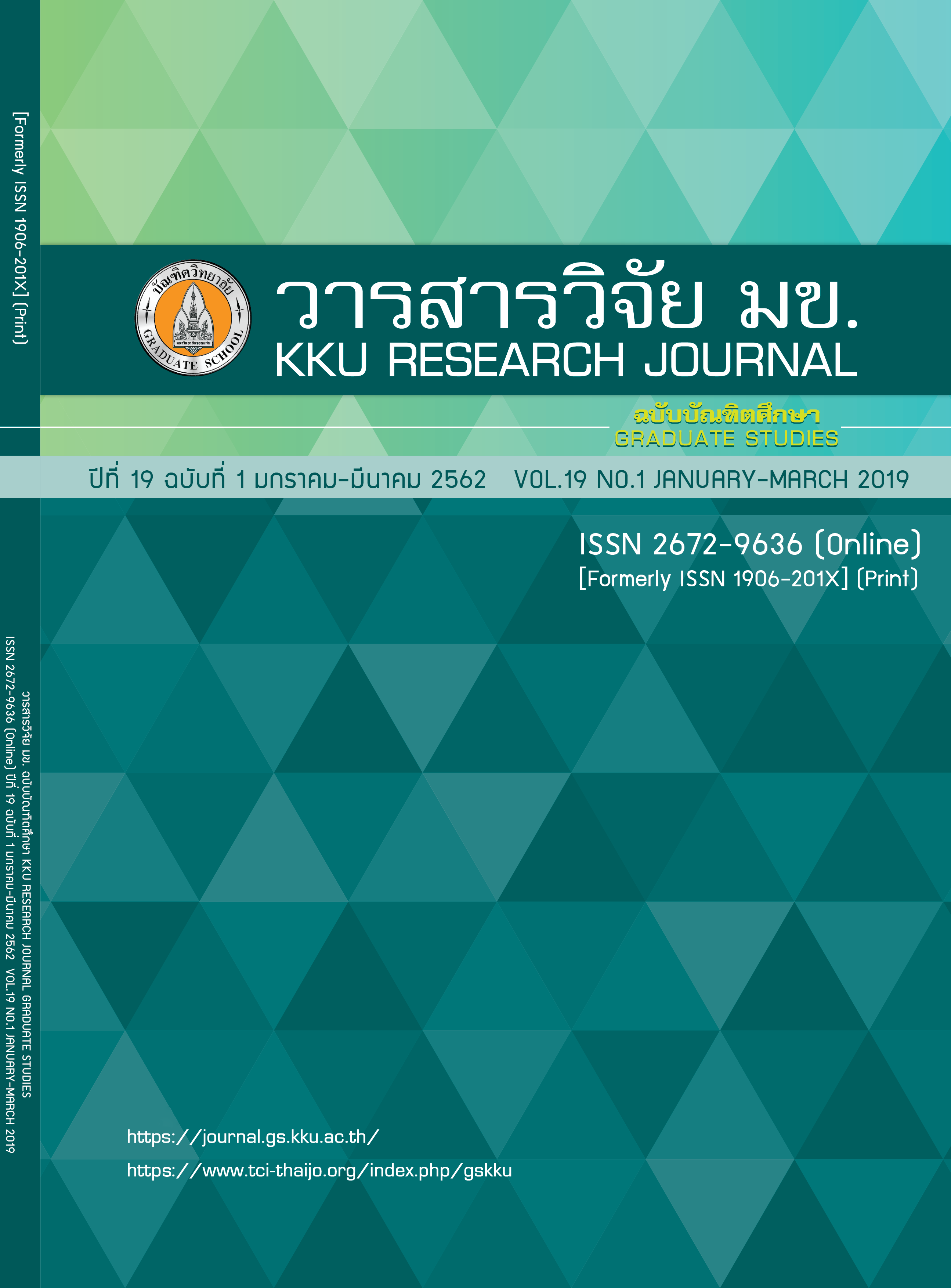Android Application Development for Estimating Properties and Preliminary Stability of Rock Mass using Rock Mass Rating and Geological Strength Index
Keywords:
Android application, Rock Mass Rating (RMR), Geological Strength Index (GSI)Abstract
Rock mass stability is one of the key factors which influence mining and civil engineering operations. Rock mass rating (RMR) and geological strength index (GSI) are very useful classification theories for estimating preliminary rock mass properties and stability with discontinuities analysis. Engineers can plan their work properly and safely if they know the stability of the rock mass. Android smartphone are portable devices that have a microprocessor. PSU-RG Android application was developed for estimating the stability of rock mass using rock mass rating and geological strength index. The application allows users to evaluate rock mass stability instantly in the field. PSU-RG application was verified for reliable and accurate estimations. The application was tested with geological data from other researches (case studies), the results are satisfied.
References
2. Hamidi JK, Shahriar K, Rezai B, Rostami J. Performance prediction of hard rock TBM using Rock Mass Rating (RMR) system. Tunnelling and Underground Space Technology. 2010; 25(4): 333-345.
3. Bertuzzi R, Douglas K, Mostyn G. Comparison of quantified and chart GSI for four rock masses. Engineering Geology. 2016; 202: 24-35.
4. Bertuzzi R, Douglas K, Mostyn G. Improving the GSI Hoek-Brown criterion relationships. International Journal of Rock Mechanics and Mining Sciences. 2016; 89: 185-199.
5. Hong K, Han E, Kang K. Determination of geological strength index of jointed rock mass based on image processing. Journal of Rock Mechanics and Geotechnical Engineering. 2017; 9(4): 702-708.
6. Boonbatr A, Fuenkajorn K. Design and analysis of adit for limestone quarry of Siam City Cement Public Company Limited. Proceedings of Thailand Rock Mechanics Symposium; 2011 Mar 10-11; Phetchaburi, Thailand.
7. Tonnayopas D. Rock Slope Assessment of Carbonate Rock Quarries Using Stereo-net Projection Method and Rock Mass Classification. University of the Thai Chamber of Commerce Journal Science and Technology. 2014; 1(2): 1-17. Thai.
8. Beemer HD, Worrells DS. Conducting Rock Mass Rating for tunnel construction on Mars. Acta Astronautica. 2017; 139: 176-180.
9. Smartphone OS Market Share, 2017 Q1 [Internet] 2017 [cited 2018 Feb 25]. Available from: https://www.idc.com/promo/smartphone-market-share/os
10. GeoToolbox [Internet] 2013 [cited 2018 Feb 27]. Available from: https://play.google.com/store/apps/details?id=appinventor.ai_marco_filipponi.GeoToolbox
11. RMR Calc [Internet] 2014 [cited 2018 Feb 27]. Available from: https://play.google.com/store/apps/details?id=es.terrasolum.rockmassratingcalc2
12. Geostation [Internet] 2014 [cited 2018 Feb 27]. Available from: https://play.google.com/store/apps/details?id=es.terrasolum.geostation
13. Assis D. Slope Mass Rating (SMR) [Internet] 2016 [cited 2018 Feb 27]. Available from: https://play.google.com/store/apps/details?id=com.projecto.diogoassis.smr
14. Pantaweesak P, Sontamino P, Tonnayopas D. Android Application Development for Estimating Rock Slope Stability using Slope Mass Rating (SMR). Proceedings of the 6th Science, Engineering and Resources Undergraduate Conference; 2017 Apr 29; Songkhla, Thailand.
15. Pantaweesak P, Sontamino P, Tonnayopas D, Vattanasak H. PSU-RSR v.1: An Initial Android Application for Estimating Rock Mass Stability. Proceedings of Coal Mining and Utilization for Sustainable Development International Conference; 2017 Nov 23-24; Lampang, Thailand.
16. Sarangi R. Rock Mass Classification [Internet] 2013 [cited 2018 Feb 27]. Available from: https://play.google.com/store/apps/details?id=com.rakeshsarangi.rockmassclassification
17. Singh B, Goel RK. Engineering Rock Mass Classification: tunneling, foundations, and landslides. New York: Elsevier; 2011.
18. Bieniawski ZT. Determining rock mass deformability, experience from case histories. International Journal of Rock Mechanics and Mining Sciences & Geomechanics Abstracts. 1978; 15(5): 237-247.
19. Bieniawski ZT. Rock mechanics design in mining and tunneling. Rotterdam: Balkema AA; 1984.
20. Palmstrom A. Recent developments in rock support estimates by the RMi. Journal of Rock Mechanics and Tunnelling Technology. 2000; 6(1): 1-19.
21. Nogkeaw W, Tonnayopas D, Rachpech V. Estimation of rock mass strength using GSI System and rock slope stability by stereographic projection. Proceedings of the 5th PSU-UNS International Conference on Engineering and Technology; 2011 May 2-3; Phuket, Thailand.
22. Deere DU, Deere DW. Rock quality designation (RQD) after twenty years. Contract report. Gainesville (FL): Department of the Army, US Army Corps of Engineers; 1989 Feb. Report No.: GL-89-1.
23. Palmstrom A. Measurements of and correlations between block size and rock quality designation (RQD). Tunnelling and Underground Space Technology. 2005; 20(4): 362-377.
24. Bieniawski ZT. Classification of rock masses for engineering: The RMR system and future trends. In: Hudson JA, editor. Comprehensive Rock Engineering. Oxford: Pergamon Press; 1993. p. 553-574.
25. Bieniawski ZT. The geomechanics classification in rock engineering applications. Proceedings of the 4th Congress of the International Society for Rock Mechanics; 1979 Sep 2-8; Montreux, Switzerland.
26. Bieniawski ZT. Engineering classification of jointed rock masses. The Civil Engineer in South Africa. 1973; 15(12): 335-343.
27. Waltham T. Foundations of Engineering Geology. 2nd ed. Abingdon: Taylor & Francis; 2002.
28. Hoek E, Brown ET. Practical estimates of rock mass strength. International Journal of Rock Mechanics and Mining Sciences. 1997; 34(8): 1165-1186.
29. Cai M, Kaiser PK. Visualization of rock mass classification systems. Geotechnical and Geological Engineering. 2006; 24(4): 1089-1102.
30. Cai M, Kaiser PK, Uno H, Tasaka Y, Minami M. Estimation of rock mass deformation modulus and strength of jointed hard rock masses using the GSI system. International Journal of Rock Mechanics and Mining Sciences. 2004; 41(1): 3-19.
31. Palmstrom A. RMi – a system for characterizing rock mass strength for use in rock engineering. Journal of Rock Mechanics and Tunnelling Technology. 1995; 1(2): 1-40.
32. Hoek E, Marinos P, Benissi M. Applicability of the Geological Strength Index (GSI) classification for very weak and sheared rock masses - the case of Athens schist formation. Engineering Geology and Environment. 1998; 57(2): 151-160.
33. Android Studio [Internet] 2017 [cited 2018 Feb 27]. Available from: https://developer.android.com/studio/index.html
34. Weng YH, Sun FS, Grigsby JD. GeoTools: An android phone application in geology. Computers & Geosciences. 2012; 44: 24-30.
35. Novakova L, Pavlis TL. Assessment of the precision of smart phones and tablets for measurement of planar orientations: A case study. Journal of Structural Geology. 2017; 97: 93-103.
36. Allmendinger RW, Siron CR, Scott CP. Structural data collection with mobile devices: Accuracy, redundancy, and best practices. Journal of Structural Geology. 2017; 102: 98-112.



